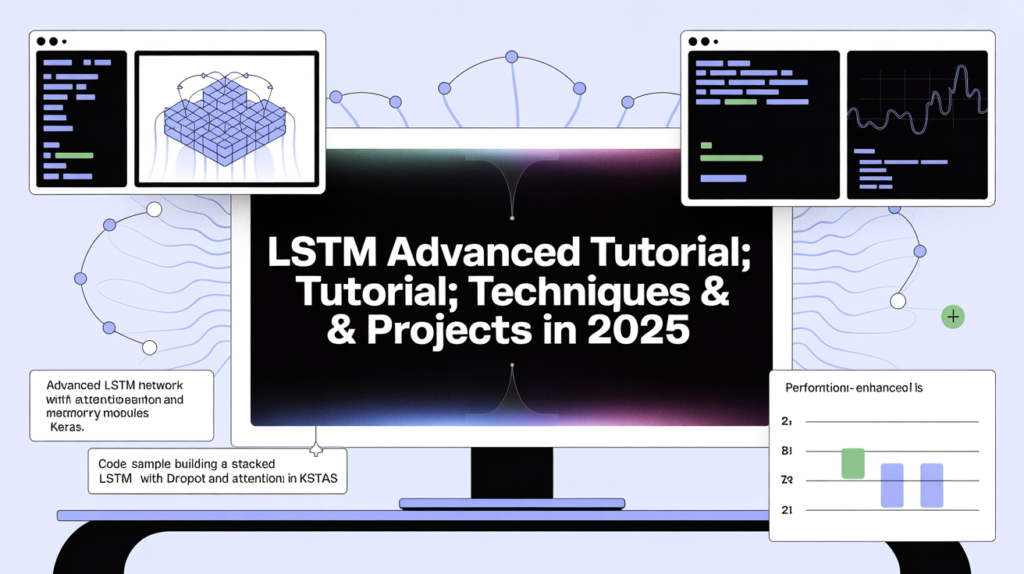LSTM Advanced Tutorial: Techniques & Projects in 2025

Introduction to This LSTM Advanced Tutorial
Welcome to the most up-to-date lstm advanced tutorial for 2025. If you’ve already built your first LSTM model and are ready to scale your skills to real-world deployment, multimodal learning, and cutting-edge research, this is your roadmap. As transformer models continue dominating attention, LSTMs are evolving with advanced integrations, hybrid architectures, and custom applications in time-sensitive, interpretability-critical environments.
In this tutorial, we’ll explore deep lstm advanced techniques, covering optimization tricks, reinforcement learning integrations, meta-learning loops, and distributed model deployment. Whether you use TensorFlow or Keras, we’ll walk through powerful code examples, real-world projects, and best practices based on the latest research in 2025.
1. Beyond Basics: Advanced LSTM Architectures
1.1 Hierarchical LSTMs
Stack multiple LSTM layers with intermediate outputs feeding into another LSTM for long-context document understanding or time-series abstraction.
from tensorflow.keras.models import Model
from tensorflow.keras.layers import Input, LSTM, Dense
inputs = Input(shape=(None, feature_dim))
x = LSTM(64, return_sequences=True)(inputs)
x = LSTM(32)(x)
outputs = Dense(1)(x)
model = Model(inputs, outputs)This pattern works well for hierarchical forecasting, text summarization, or video understanding.
1.2 Attention-Enhanced LSTM
Add attention layers over LSTM outputs to improve sequence modeling.
# Add Bahdanau or Luong attention using `AdditiveAttention` from TensorFlowCombining LSTM memory with attention boosts performance in sequence-to-sequence tasks, making your model far more context aware.
2. Optimization Tricks for 2025
2.1 Schedulers & Learning Rate Control
Try advanced learning rate schedules like cosine decay or warm-up:
lr_schedule = tf.keras.optimizers.schedules.CosineDecay(initial_learning_rate=0.001, decay_steps=1000)
optimizer = tf.keras.optimizers.Adam(learning_rate=lr_schedule)2.2 Loss Function Tweaks
Use Huber loss or quantile loss for time-series models to handle outliers better.
model.compile(loss='huber', optimizer=optimizer)2.3 Regularization
Add dropout not only to inputs but also recurrent_dropout within LSTM:
LSTM(128, dropout=0.2, recurrent_dropout=0.2)These approaches help you avoid overfitting and improve generalization, especially in lstm advanced tutorial tensorflow builds.
3. LSTM + Reinforcement Learning
In 2025, sequence-aware RL agents powered by LSTM memory cells are trending in:
- Finance (adaptive trading)
- Robotics (motion planning from temporal data)
- Gaming AI (strategy recognition)
Here’s how to plug LSTM into a PPO agent:
# LSTM policy network inside OpenAI Gym-compatible agentUsing LSTM for internal memory helps agents remember partial observations, enabling better policy decisions—an essential concept in lstm advanced applications.
4. Meta-Learning & Adaptive Learning Systems
4.1 LSTM for Meta-Controller
Use an LSTM to control parameter updates in another model—a core idea in learning to learn setups.
- MAML (Model-Agnostic Meta-Learning) + LSTM for task adaptation.
- Few-shot learning using LSTM’s internal memory to adapt quickly.
This technique has become standard in 2025 for federated and few-sample learning.
4.2 Memory-Augmented Networks
Combine LSTM with external memory banks (like Differentiable Neural Computers) for powerful learning systems that recall past tasks and generalize.
5. Distributed Training for LSTM at Scale
Scaling LSTMs was once hard—now in 2025, it’s easier than ever.
5.1 Multi-GPU via tf.distribute
strategy = tf.distribute.MirroredStrategy()
with strategy.scope():
model = build_model()5.2 TPU Training
Fine-tune TensorFlow code for compatibility with Google Cloud TPUs and train LSTMs 5x faster.
5.3 Model Checkpointing and Restarting
Use callbacks to checkpoint models during long training jobs.
tf.keras.callbacks.ModelCheckpoint('lstm_model.h5', save_best_only=True)These tricks are vital for large-scale lstm advanced projects.
6. Advanced LSTM Applications in 2025
LSTMs remain powerful in real-time, explainable, and low-latency systems.
Healthcare
- ECG signal anomaly detection
- EEG-based seizure prediction
- Real-time vitals forecasting in ICUs
Finance
- Sequence prediction for volatility modeling
- Multimodal inputs (news sentiment + prices)
Text + Time-Series Fusion
- Product review trends + demand forecasting
- Social media sentiment + ad spend efficiency
These scenarios prove LSTM is still thriving where Transformers may be overkill.
7. Visualization and Debugging Tools
- Use TensorBoard to analyze LSTM hidden states, gate outputs
- Use WandB for experiment tracking
- Plot sequence attention weights for explainability
Best Practices and Troubleshooting in 2025
| Problem | Fix |
|---|---|
| Overfitting | Add dropout, early stopping, reduce model size |
| Vanishing gradient | Clip gradients, normalize sequences |
| Long training time | Use mixed-precision, TPU, or cosine decay scheduler |
| Poor generalization | Try different initializations, use Huber or contrastive loss |
Links & Research Resources
- LSTM optimization in TensorFlow: tensorflow.org
- Deep Learning research updates: arxiv-sanity.com
- Keras advanced recurrent layers: keras.io
- AutoML + NAS for LSTM: keras-tuner
✅ Frequently Asked Questions (FAQs)
1. Is LSTM still used in 2025?
Yes—especially in time-series, healthcare, and low-latency systems. New advanced implementations have kept LSTM highly relevant.
2. Can I combine attention with LSTM?
Absolutely. Many 2025 models use attention-augmented LSTM for improved performance.
3. Is LSTM better than Transformer?
It depends. For real-time or interpretable models, LSTM is often the better fit. Transformers dominate large NLP tasks.
4. What advanced topics are covered here?
Hierarchical modeling, attention integration, reinforcement learning, meta-learning, and large-scale training.
5. Where can I find real-world datasets?
Check Kaggle, UCI Machine Learning Repository, and TensorFlow Datasets.
🧩 Get Started: Check Out These Guides on Python Installation
Working with LSTM neural networks often means setting up Python correctly, managing multiple versions, and creating isolated environments for your deep learning experiments.
To make sure your LSTM models run smoothly, check out these helpful blogs on Python installation:
📌 Python 3.10 Installation on windows
📌 Python 3.13 (latest) installation guide – easy and quick installation steps
Discover more from Neural Brain Works - The Tech blog
Subscribe to get the latest posts sent to your email.

Your passion for your subject matter shines through in every post. It’s clear that you genuinely care about sharing knowledge and making a positive impact on your readers. Kudos to you!